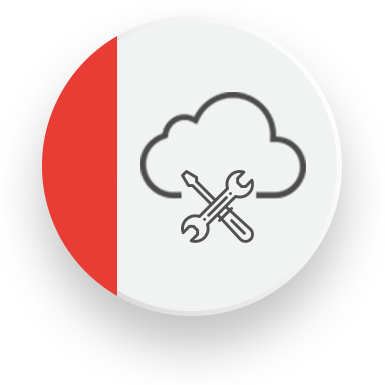What Next.
Prepare for infinite iterations of this question. Technology is advancing at an unprecedented rate, and disruptive innovation is the catalyst of this age. The future is leaner, faster, connected, mobile and driven by accelerated change. Is your business ecosystem ready for it?
In the digital era, data is ubiquitous. It is the lifeblood coursing through organizations great and small. Whether you are looking to gain a competitive edge, bolster business strategy with actionable insights, make quick edits to employee records or build meaningful relationships with customers, there is a staggering amount of data to reckon with.

Many businesses have responded to this challenge with a tools approach – a major investment in various best-in-class data management applications that cater to specific functional needs. But this is fraught with difficulties: managing data across disparate systems is expensive, laborious and time-consuming – and delivers results that are often too slow or ambiguous to be relevant.
With radical advancements in cloud technology, artificial intelligence, machine learning and robotic process automation, the tools approach is being retired in favor of an ecosystem approach – a single unified platform that delivers accurate data and meaningful insights at a fraction of the cost of on-premise applications – while saving hundreds of man-hours. In moving from a digital scaffolding to a digital core, businesses are empowered by cutting-edge technology that is accessible, affordable and optimized to precisely serve their needs.
Accelerated Digital Transformation.

Strategy and Advisory.
Drivestream’s strategy and advisory services help assess your cloud readiness and demystify the cloud transition. Our precisely crafted tools like the TCO calculator and the Cloud Migration Assessment (CMA) offer a strategic ring-side view of a cloud implementation. These allow you to accurately determine costs, savings and fitment, helping you understand exactly what it takes to make the cloud leap – while aiding you in making a strong business case for the transition.

The TCO Calculator is a powerful tool that calculates the reduction in Total Cost of Ownership if you migrate your current applications to the Cloud. Using real-world client data, the TCO Calculator provides a clear picture of your estimated savings in easy-to-understand terms, giving you a precise view of the Cloud transition.
Key questions answered:
- What is the impact on my Total Cost of Ownership?
- What is the Cloud’s financial value proposition?

Estimated TCO reduction by years 4 to 5: ~50%
Five-year cumulative savings: Approx. $3,294,082

The CMA is a collaborative workshop involving senior stakeholders across business units where we learn about your business, analyze your customizations, look at your infrastructure, and understand your staffing needs.
Key questions answered:
- Will the Cloud be a fit for my company?
- Which of my business functions should move to the Cloud and which should stay On-Premise?
- What about our customizations? How will gaps be addressed?
- What will be our roadmap and roll-out plan? Should we move all at once or in phases?
- How do I justify my project and budget?
- How will my organization handle change management and business transformation issues?
- Can my people support the Cloud?
- How do I evaluate and hire an implementation partner?
The CMA then takes you through layered steps to cloud clarity including intensive explorations of cloud operations, functional architecture, technical architecture and roadmap development.
At the end of the assessment, we have mapped all key business processes – including customizations and integrations – and present you with a cost saving, limited-risk path for your journey to the Cloud.
Cloud Migration.
Does your SaaS investment give you Silos as a Service? It’s time to make the cloud leap.
Oracle Integration Cloud Service.
Say hello to intelligent integration. Critical business processes that are the building blocks of any enterprise – Human Resources, ERP, Financial Management and Accounting, Supply Chain, Sales and Customer Experience – are all candidates for cloud migration. On a single unified platform with powerful real-time capabilities and advanced analytics, they will be seamlessly connected and highly interoperable – rendering complex, voluminous data both user-friendly and useful.
But what about your customizations?
The unique needs of your business model need not be sacrificed in order to navigate a best-of-breed vs. standardization dichotomy. We don’t believe in dichotomies. We prefer the duality of SaaS and PaaS.
With Oracle, you get to harness state of the art technology in every form: comprehensively built Cloud applications, pre-built integration flows for SaaS and on-premise applications, visual application development tools for DIY mobile and web apps, low-code and no-code workflows and AI-enhanced automation – all with easy data mashup across the board.
SaaS

PaaS

Digital Enhancement.
Artificial Intelligence is here, alongside Machine Learning, chatbots, Robotic Process Automation and more. But it’s not a sign to scramble for a copy of Asimov’s laws. Bleeding edge AI-driven technology is here to extend – rather than replace – your traditional workforce.
Delegate repetitive, time-consuming tasks to digital assistants, build workflows to automate processes, communicate with clarity and troubleshoot without hassle using a range of tools designed to minimize effort, maximize output and drastically improve the quality of work.
Liberate your workforce from the drudgery of data labor and empower your employees to engage in more strategic pursuits, leading to better business decisions and sustained growth impetus.
Machine Learning.
Data management as a standalone endeavor is passé. Businesses are now looking for a “thinking database” – one that offers useful insights and intelligent recommendations. ML provides the predictive edge that companies need in a time of omnipresent data.
Oracle allows you to embed ML algorithms in-database, eliminating data duplication and separate analytical servers in favor of a lean model that allows you to effectively operationalize ML insights without import, extraction or extended waiting times.
With multilingual ML capabilities spanning SQL, R, Python, Workflow UI, Notebooks and embedded ML in applications, Oracle provides the fastest, most adaptable way to deliver enterprise-wide predictive analytics.
ML powers advanced data models for businesses to understand their customers better and optimize services to suit their needs.

Oracle’s prebuilt analytical ML methodologies and algorithms include:
Chatbots.
Manually fielding hundreds of queries throws up limitations of time and time zones, domain knowledge, authority and access, hierarchical visibility and more. Simply put, your employees are wasting precious time interfacing with customers rather than championing solutions. Chatbots ease this burden by providing an efficient, expedited and personalized alternative to human responses.
As a feature of Oracle Cloud Platform, Chatbots use natural language processing and Machine Learning to identify intents, follow context within conversations and automate engagements. The platform allows you to build, test and deploy bots both on chat apps as well as part of a chat interface on other branded apps.
The nature of communication has fundamentally changed in the digital era. In a world dominated by multi-tasking, mobility and ease of access, mobile messaging is the most preferred form of communication. The expectation from such communication has also evolved – people don’t want responses; they need solutions. And yet, companies that manually manage their pages take on an average 10 hours to respond to messages, and even then only provide an acknowledgement with a promise of further action. This can be a frustrating experience for customers, who have come to expect 24/7 services and expedited response.

There are two types of chatbots:
Chatbots aren’t just useful for liaising with customers. They can help connect the dots in internal communication, bolstering processes such as recruitment, procurement, financial audits and more by leveraging centralized platform data and task capabilities like scheduling, purchasing and approvals.
Robotic Process Automation.
RPA is a form of adaptive intelligence that is capable of mimicking human behavior on apps and systems – from simple keystrokes to complex, multi-step system interactions. Although the “R” in “RPA” is evocative of steel muscle and box heads, it is for all practical purposes, simply an advanced form of existing system automation. What has changed is the level of connectivity and interoperability on one hand and the sophistication of multi-layered task execution capabilities on the other.
RPA is also fundamentally non-invasive and can be directed towards optimizing specific processes rather than demanding a major transformation with complex integrations. Acting as a digital extension to the human workforce, it allows enterprises to build, integrate and engage at scale. It eases costs, increases efficiency and enables businesses to realize greater IT benefits from existing infrastructure.

Mobile.

The digital world is a mobile-first experience. As the primary ground for customer and stakeholder engagement, the smartphone is the natural target of enterprise app developers. But the organizational focus on mobile-optimized services has often meant unsuccessfully confronting the standard challenges of development and deployment: build-from-scratch scenarios that reinvent basic functions and get mired in persistent UI struggles, broken feedback loops and disconnected experiences.
Oracle Mobile Cloud Services provide a feature-rich, collaborative digital platform that allows you to simplify and elevate the process of mobile engagement. With ready access to an API catalog, intelligent bot services, versatile framework-to-backend integration options, low-code development and actionable analytics, Oracle helps you rapidly develop, integrate, analyze and manage mobile apps.












